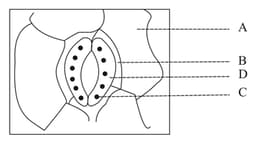Define stomatal transpiration.
Important Questions on Plant Water Relation
Study the diagram and the list given below.

i) Chloroplast
ii) Epidermal cell
iii) Guard cell
iv) Subsidiary cell
v) Stomatal pore
The correct match is
|
List I |
List II |
| A. Cohesion | I. More attraction in liquid phase |
| B. Adhesion | II. Mutual attraction among water molecules |
| C. Surface tension | III. Water loss in liquid phase |
| D. Guttation | IV. Attraction towards polar surfaces |
Choose the correct answer from the options given below:
Given below is a diagram of the stomatal apparatus. Match the labels with the corresponding names of the compounds.

Choose the correct combination.
Given below are two statements:
Statement I: The forces generated by transpiration can create pressures sufficient to lift a xylem sized column of water over 130 metres high.
Statement II: Transpiration cools leaf surfaces, sometimes 10 to 15 degrees, by evaporative cooling.
In the light of the above statements, choose the most appropriate answer from the options given below:
Identify the correct match of the type of water given in column-I and its character in column-II and select the correct option.
| Column-I | Column-II | ||
| (i) | Capillary water | (a) | present in the form of hydrated oxides of silicon and aluminium. |
| (ii) | Hygroscopic water | (b) | goes down through large pores between soil particles and reaches the water table. |
| (iii) | Combined water | (c) | held in between small non-colloidal soil particles. |
| (iv) | Gravitational water | (d) | held tightly around soil particles by adhesive forces. |
In a plant organ, which is covered by periderm and in which the stomata are absent, some gaseous exchange still takes place through:

